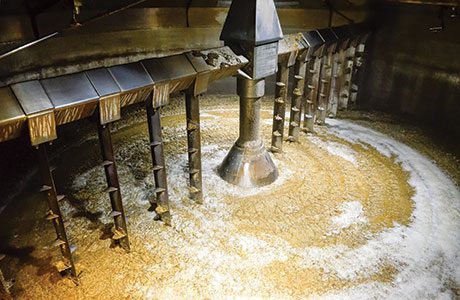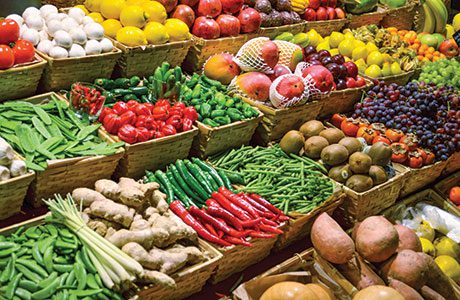A panel of experts gathered in Edinburgh in December to discuss the topic “Cleantech: The key ingredient for a sustainable food and drink industry?” The event offered a range of opinions on technologies like biomass heating and energy recovery, and how they could be applied in areas like farming and whiskey production. Paul Marsh reports.
HOW sustainable is the food and drink industry? When you look at some of the statistics it’s tempting to conclude that its eyes have so far been bigger than its belly when it comes to things like renewable energy and embracing the circular economy. The big 10 food and drink companies in the world contribute more greenhouse gases than Scandinavia; if they were a country, they’d be the 20th most polluting in the world.
Vying for an opportunity to tell a different story, or at least to discuss the challenges at hand, were a panel that included Robert Ramsay, founder of “Scotland’s largest precision farming company”, Soil Essentials; Julie Hesketh-Laird, director of technical operations (and deputy CEO) with the Scotch Whiskey Association, the principal trade association for the sector; Andrew Lyle, md of renewable energy firm Locogen; and Willie Ferguson, key account manager, retail food and drink, with Resource Efficient Scotland. The event was organised by networking organisation eCoConnect.

An industry worth £16.5 billion (citing 2015 figures), the food and drink sector faces huge challenges in the years ahead, addressing the needs of a rising global population in an era of growing resource scarcity. The food system needs to become increasingly sustainable and to address the challenges of climate change. Current estimates hold that food production will have to increase by 40% by 2040, and 70% by 2050, according to the moderator for the evening, Fraser Geddes, a partner with law firm Anderson Strathearn.
The progress made towards these goals already is “impressive” but, looking to the future, what areas present the greatest opportunities for cleantech? And what are the main barriers to its use in the sector?
Ferguson – paraphrasing a well-known farmer in Scotland, Jim McLaren – mentioned that, if you’re looking to find a receptive ear in the farming community, it’s a case of “don’t talk to them about how to reduce carbon footprint, but how to reduce costs”. The challenging cost constraints in this sector should prompt a rethink of business models on the part of food retailers. But the agricultural sector has already seen a lot of investment in renewables, and it has the land and space to make the most of such opportunities.
Andrew Lyle said that wind and solar are less of a safe bet for the food and drink industry, the former being dogged by planning issues and the latter unable to make much of an impact on energy requirements. His company has looked at biomass heating for this sector, which was “challenging”. But there is a great opportunity to generate clean power by feeding the waste products from this sector into AD systems. There is a good baseload and the energy production is “not seasonal”, so offers a fairly ongoing source of power.
Robert Ramsay concurred that for farmers “the pressure is all on price, not carbon footprint”, and described some of the initiatives underway in the precision farming sector. ESA is putting up satellites that can give weekly reports on crops, feedback that can be used to optimise yields. There are also tractor-based systems that can gather this kind of information.
Two-headed consumer
Speaking on behalf of the whiskey industry, Hesketh-Laird said: “Our consumers, especially in overseas markets, want: (1) for us to be the greenest, and (2) to be able to pick up a bottle and have something very high end.” This problem of the “two-headed consumer” is one for which “help is needed from the packaging industry to crack”. Her sector has been setting itself very challenging targets with packaging, but consumer demand is going in the opposite direction.
She added that the agricultural impact of whiskey distilleries is “pretty big”, and accounts for “almost half of what we do”. So there is definitely a need to engage with the agricultural supply chain. She cited in particular the opportunity to turn Scotland into a “real centre of excellence for barley”. A crucial ingredient in malts, she alluded to a need for Scotland to do more to look after its barley supply. “If we want to keep our barely scientists here, we need investment.”
Another questioner seemed to bemoan the missed opportunities in the food and drink industry for making more use of waste heat. Speaking about Scotch whiskey, Hesketh-Laird mentioned the strict regulations that affect how you can produce Scotch whiskey. The Scotch Whiskey Research Institute at Riccarton are doing their best to test at the edges of legislation and science, she said, and “who knows when the first electric still might come online”. There is serious work going on in every distillery in Scotland, to find ways to capture heat and use it to preheat the mash tun, for instance. The Climate Change Levy has been a big driver here, as have energy costs. And the whiskey industry has been “a leader in switching sources of energy” towards more renewable options. Now 16% of all energy used in distilling in Scotland is non-fossil. “So we’re doing a lot but it’s research that will get us to the next level,” she said.

Somewhere to take the heat
As for the recovery of waste heat, not all distilleries are located in areas where there is an obvious heat sink. “We are trying to map out where the opportunities are,” she said, but – speaking for much of the sector – concluded: “Until we can store heat, it’s going to be difficult.” One place where it has worked is the Morrison-Bowmore distillery on Islay, where waste heat is piped into a swimming pool next door.
Another audience member asked about the contentious issue of growing crops to provide feedstocks for AD systems. Ramsay said: “People in the west don’t starve to death, but they do freeze to death.” People seem content with the growing of flowers on agricultural land, so why not fuel? “It’s crazy this view that food is sacrosanct,” he said.
Fuel crop contention
Hesketh-Laird said there had been controversy over distillery companies using animal feed and turning it into energy. But she felt the conventional objections to what arguably amounted to taking feed off the UK market and turning it into fuel didn’t really stack up in the face of a declining dairy industry, especially in Scotland. “In the past decade spirits production has doubled while cattle has declined,” she said, adding: “I’m confident with where we’re at.”
Near the end of the session, an audience member asked: “Is it possible to describe food and drink as sustainable? And who is educating the consumer?”
“Crikey,” said Hesketh-Laird. “Can we educate them? We do, we try.” She mentioned that, with respect to packaging, some of the barriers are technological. “If we can lightweight the really fancy bottles, that’s a big opportunity,” she said, before concluding that “yes”, her industry is sustainable, but then it depends how you define sustainable.
Reducing waste with the retailer
Lyle felt that “no, it’s not sustainable now”, but could become so, with investment. Ferguson mentioned the Co-operative Food supermarket, which has been working with Scottish potato farmers on reducing waste. Findings had shown that the potato sector had waste levels of 60%, around 30 to 40% of which were commonly attributable to retailers. Steps taken to reduce the waste on this side have included a more judicious choice of which varieties of potato to use, bearing in mind that some waste more easily. Improvements have also been made with storage and the griddle sizes used during processing, a factor that has saved a lot of stock from becoming cattle feed. On the consumer side of things, he said: “I think we’ve got to uneducate the consumer”, referring to the way we are all educated to look for perfect potatoes when we go to the supermarket. “Just because they’ve got a blemish [ we don’t pick them ] – they’re still nutritious, and perfectly good value.” But the retailer or supplier is guilty of this kind of waste too, he said, citing a company in Yorkshire with a machine that photographed potatoes, automatically chucking out the ones that didn’t look right.
All in, it was an event that combined generous usage of the word “opportunity” with seemingly rueful acceptance of the cost-driven realities that have driven many aspects of the food and drink sector up until now. Changes in business models, consumer attitudes and technology will be needed to move things on, the panel seemed to think.






